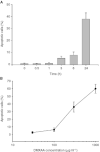Induction of endothelial cell apoptosis by the antivascular agent 5,6-Dimethylxanthenone-4-acetic acid
- PMID: 12085190
- PMCID: PMC2375421
- DOI: 10.1038/sj.bjc.6600368
Induction of endothelial cell apoptosis by the antivascular agent 5,6-Dimethylxanthenone-4-acetic acid
Abstract
5,6-Dimethylxanthenone-4-acetic acid, synthesised in this laboratory, reduces tumour blood flow, both in mice and in patients on Phase I trial. We used TUNEL (TdT-mediated dUTP nick end labelling) assays to investigate whether apoptosis induction was involved in its antivascular effect. 5,6-Dimethylxanthenone-4-acetic acid induced dose-dependent apoptosis in vitro in HECPP murine endothelial cells in the absence of up-regulation of mRNA for tumour necrosis factor. Selective apoptosis of endothelial cells was detected in vivo in sections of Colon 38 tumours in mice within 30 min of administration of 5,6-Dimethylxanthenone-4-acetic acid (25 mg x kg(-1)). TUNEL staining intensified with time and after 3 h, necrosis of adjacent tumour tissue was observed. Apoptosis of central vessels in splenic white pulp was also detected in tumour-bearing mice but not in mice without tumours. Apoptosis was not observed in liver tissue. No apoptosis was observed with the inactive analogue 8-methylxanthenone-4-acetic acid. Positive TUNEL staining of tumour vascular endothelium was evident in one patient in a Phase I clinical trial, from a breast tumour biopsy taken 3 and 24 h after infusion of 5,6-Dimethylxanthenone-4-acetic acid (3.1 mg x m(-2)). Tumour necrosis and the production of tumour tumour necrosis factor were not observed. No apoptotic staining was seen in tumour biopsies taken from two other patients (doses of 3.7 and 4.9 mg x m(-2)). We conclude that 5,6-Dimethylxanthenone-4-acetic acid can induce vascular endothelial cell apoptosis in some murine and human tumours. The action is rapid and appears to be independent of tumour necrosis factor induction.
Copyright 2002 Cancer Research UK
Figures



References
-
- BaguleyBC2001Small-molecule cytokine inducers causing tumor necrosis Curr Opin Investig Drugs 2967975 - PubMed
-
- BaguleyBCCalveleySBCroweKKFrayLMO'RourkeSASmithGP1989Comparison of the effects of flavone acetic acid, fostriecin, homoharringtonine and tumour necrosis factor alpha on Colon 38 tumors in mice Eur J Cancer Clin Oncol 25263269 - PubMed
-
- BizouarneNMitterrandMMonsignyMKiedaC1993Characterization of membrane sugar-specific receptors in cultured high endothelial cells from mouse peripheral lymph nodes Biol Cell 792735 - PubMed
-
- BrowneWLWilsonWRBaguleyBCChingL-M1998Suppression of serum tumour necrosis factor-alpha by thalidomide does not lead to reversal of tumour vascular collapse and anti-tumour activity of 5,6-dimethylxanthenone-4-acetic acid Anticancer Res 1844094414 - PubMed
Publication types
MeSH terms
Substances
LinkOut - more resources
Full Text Sources
Medical

